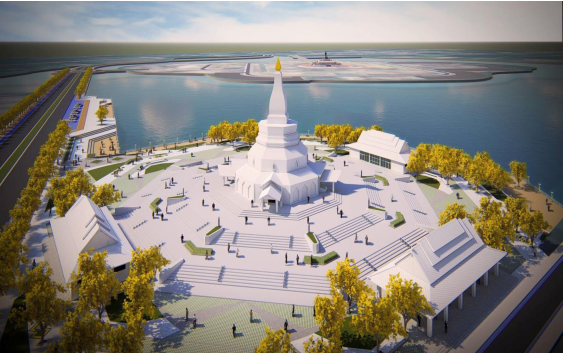The Monumental Building of Prathep - Widhayakhom : Architectural Design for Sustainable
Main Article Content
Abstract
The Monumental Building of Prathep - widhayakhom (Khoon Parisutho, venerable monk) is designed for the memory of his cremation ceremony, for people to study his innumerable benefactions, and for other related activities. This building is designed by Faculty of Architecture, Khon Kaen University team and this building design have been related to "Sustainable Design Concept" which comprised of (1) Energy and Resource Conservation (2) Environment Impact Minimizing (3) Indoor Environmental Quality and (4) Design Integration. At current, This sustainable concept is not popular for architects and designer for monumental building. From this result of this study showed, this conceptual design can be efficiently used for this type of building.
Article Details

This work is licensed under a Creative Commons Attribution-NonCommercial-NoDerivatives 4.0 International License.
References
ชูพงษ์ ทองคําสมุทร. (2554). ภาวะโลกร้อนกับการออกแบบสถาปัตยกรรม. ขอนแก่น: โรงพิมพ์มหาวิทยาลัยขอนแก่น.
อรรจน์ เศรษฐบุตร. (2549). สถาปัตยกรรมยั่งยืนและนิเวศวิทยาคาร. กรุงเทพฯ: สํานักพิมพ์แห่งจุฬาลงกรณ์มหาวิทยาลัย.
สถาบันอาคารเขียวไทย. (2555). คู่มือสําหรับเกณฑ์การประเมินความยั่งยืนทางพลังงานและสิ่งแวดล้อมไทย. กรุงเทพฯ: สํานักพิมพ์แห่งจุฬาลงกรณ์มหาวิทยาลัย.
K. Daniel. (1997). The technology of ecological building: basic principles and measures, examples and ideas. Basel: Birkhäuser Verlag.
อรรจน์ เศรษฐบุตร. (2551). “สถาปัตยกรรมสีเขียว: การท้าทายเพื่อความยั่งยืน”, อาษา: วารสารสถาปัตยกรรมของสมาคมสถาปนิกสยามในพระบรมราชูปถัมภ์, ปีที่ 10 ฉบับที่ 6, หน้า 65-71.
วิรดา ดีราษฎร์วิเศษ และ ชูพงษ์ ทองคําสมุทร. (2556). “อิทธิพลของช่องเปิดและวัสดุอาคารต่อภาระการทําความเย็นของระบบปรับอากาศ”, วารสารวิชาการคณะสถาปัตยกรรมศาสตร์ มหาวิทยาลัยขอนแก่น ประจําปี 2556, ปีที่ 12 ฉบับที่ 2, หน้า 60-73.
ชูพงษ์ ทองคําสมุทร. (2557). “การเปลี่ยนแปลงภาระการทําความเย็นของอาคารที่มีผลมาจากชนิดของวัสดุและอัตราส่วนพื้นที่ช่องเปิดต่อพื้นที่ผนังอาคาร กรณีศึกษา จังหวัดขอนแก่น”, วารสารวิชาการคณะสถาปัตยกรรมศาสตร์ มหาวิทยาลัยขอนแก่น ประจําปี 2557, ปีที่ 13 ฉบับที่ 1, หน้า 99-114.


